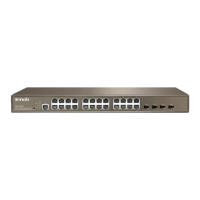User Guide
227
Port VLAN
Port-based VLANs are created by assigning ports to a VLAN.
QoS
QoS(Quality of Service) is the ability to provide different priority for different applications, users, or data
flows, or to guarantee a certain level of performance to a data flow. Delay sensitive applications such as
real-time HD streaming multimedia, voice over IP, online games and IP-TV, are often transfered on
networks where the capacity is a limited resource. Thus, a network should be able to provide a real time
lag-free Internet experience. Providing guaranteed quality of service now becomes the secret of success
in end-to-end business network solution. When configured properly, the QoS can help effectively manage
network resources.
STP/RSTP/MSTP
The Spanning Tree Protocol (STP) is a network protocol that ensures a loop-free topology for any bridged
Ethernet local area network. The basic function of STP is to prevent bridge loops and the broadcast
radiation that results from them. Spanning tree also allows a network design to include spare (redundant)
links to provide automatic backup paths if an active link fails, without the danger of bridge loops, or the
need for manual enabling/disabling of these backup links. In 1998, the IEEE 802.1w introduced Rapid
Spanning Tree Protocol (RSTP). RSTP provides significantly faster spanning tree convergence after a
topology changes, introducing new convergence behaviors and bridge port roles to do this. RSTP was
designed to be backwards-compatible with standard STP.
SNMP
SNMP Simple Network Management Protocol (SNMP) is a component of the Internet Protocol Suite for
managing devices on IP networks. The SNMP allows reverse network objects to join the network
management architecture. It monitors networks by analyzing Traps or notifications received on network
management systems.
Tag Priority
Tag Priority is a 3-byte field in 802.1Q frame, which indicates priority level.
TCP
The Transmission Control Protocol (TCP) is one of the two original components of the suite,
complementing the Internet Protocol (IP), and therefore the entire suite is commonly referred to as
TCP/IP. TCP provides a communication service at an intermediate level between an application program
and the Internet Protocol (IP).
TELNET
Telnet is a network protocol used on the Internet or local area networks to provide a bidirectional
interactive text-oriented communications facility between Telnet server and client using a virtual terminal
connection. It uses the TCP protocol.

